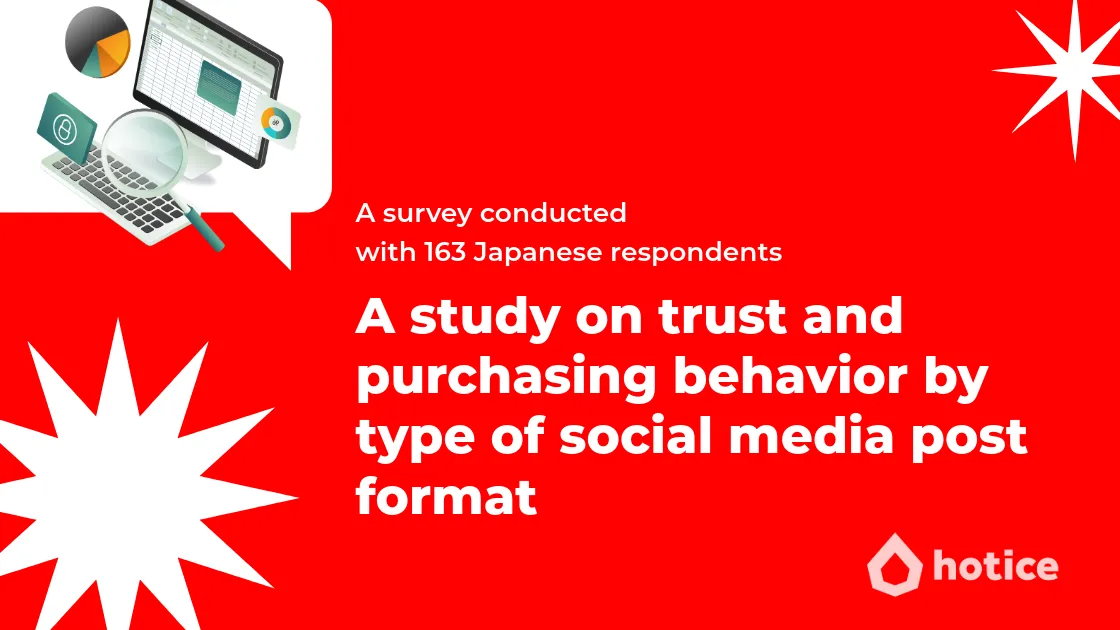What Kind of Social Media Posts Drive Purchases in Japan? A Consumer Trust and Buying Behavior Report

Social media posts in Japan have moved far beyond merely being seen.
Users now discover products through posts, and if they find them trustworthy, they are likely to take action.
What Kind of Content Do Users “Trust and Buy” From?
This report, based on a survey of 163 Japanese social media users, reveals the relationship between content format, perceived trustworthiness, and influence on behavior.
The results are clear:
The content type that users trusted the most and that led to the most actions was video.
Conversely, users expressed discomfort with posts that felt overly promotional or came off as one-sided communications from company accounts.
What Builds Trust—and What Drives Action?
What defines a trustworthy piece of content on social media?
And how should brands present their message to inspire consumer action?
This research-backed report offers practical insights for marketers, advertisers, and social media managers looking to design effective social media ads and PR campaigns for the Japanese market.
Which Types of Social Media Posts Do Users Trust?

Social media platforms offer a wide variety of content formats—but not all formats are trusted equally.
In this section, we dive into quantitative data to explore which types of posts Japanese users perceive as the most trustworthy when it comes to advertising.
By understanding these preferences, brands and marketers can tailor their content strategy to build trust more effectively and increase engagement.
The Most Trusted Format on Social Media
In response to the question, “Which type of social media content do you trust the most when it comes to advertising?”,
85 out of 163 users (51.8%) answered “video”—including review videos and how-to demonstrations.
This number significantly surpasses trust in still images and text-based posts, indicating that video has become the most trusted format for social media advertising in Japan.
One of the key reasons behind video’s popularity is its rich visual information.
It naturally conveys product usage, texture, movement, and even sound—details that static images simply cannot capture.
Furthermore, tone of voice, manner of speaking, and facial expressions add a layer of realism and sincerity, making it easier for viewers to believe that the influencer genuinely supports the product.
In contrast:
・Only 17 people (10.4%) chose “images” (e.g., product photos or carousels),
・And 14 people (8.5%) selected “text-based posts” (e.g., threads or testimonials).
This highlights a clear trend: in Japan’s social media landscape, formats that enable users to feel and experience content—rather than just read or view it—are perceived as more trustworthy.
Notably, video ranked highest across every product category in genre-based analysis (detailed below).
From the texture of cosmetics to the operation of gadgets, video content excels at delivering information that cannot be conveyed in any other format.
In short, video is no longer just a visual enhancement—it is becoming the core format for building trust.
For marketers, the key question is no longer “Should we use video?” but rather,
“What kind of video will deliver the most trust and impact?”
The Challenge of Distrust: When Format Alone Isn’t Enough
Interestingly, a significant portion of users feel that none of the common post formats on social media are truly trustworthy.
In this survey, 48 respondents (29.3%) answered, “There is no post format I particularly trust.”
This makes it the second most common response, right after “video”—a finding that cannot be ignored.
This trend reflects a broader reality: users increasingly view all SNS content through an “advertising filter.”
No matter the format, trust can be undermined if the content appears overly staged, forced, or overtly commercial.
For example,
・Overly produced videos
・Text posts that feel like one-sided corporate messaging
These types of content can easily trigger skepticism, regardless of format.
Moreover, when posts give off a strong “corporate” or “ad-like” feeling, it heightens users’ defenses.
As a result, even well-crafted posts may be dismissed as inauthentic, simply due to how they come across.
This 29.3% figure reveals a key insight:
Choosing a “trusted format” isn’t enough.
Brands must also focus on tone, transparency, and emotional distance in their messaging.
On the flip side, this finding also shows that any format has the potential to build trust—
if the content is perceived as sincere, relatable, and user-centric.
In most cases, untrustworthy content shares one trait:
the brand’s intent to sell is too obvious.
Even videos—usually the most trusted format—can be ineffective if they feel overly promotional.
Ultimately, format is just the entry point.
What truly drives trust is how the message is delivered—its authenticity, empathy, and alignment with user expectations.
What Kind of Posts Actually Drive Action?
While trusted posts tend to attract attention, the types of posts that prompt users to take action often have distinct characteristics.
In this section, we analyze:
・What actions users took after viewing a social media post
・Which content formats were most effective in prompting those actions
By understanding the link between post format and user behavior, marketers can design content that not only builds trust—but also converts interest into tangible engagement, such as product searches, website visits, or actual purchases.
Video: A Format That Not Only Builds Trust—but Drives Action

The survey also explored what specific actions users took after seeing a social media post.
The most common response was “searched on Google or other platforms,” selected by 59.2% of respondents.
This was followed by:
・“Viewed the product on an e-commerce site” (38.4%)
・“Purchased the product” (28.7%)
These results clearly show that social media content is directly connected to users’ next actions—it doesn’t end with viewing.

So, which content format most effectively triggered those actions?
When asked to select which formats prompted their behavior (multiple answers allowed),
“Video” was chosen the 77.8%—
even more than the 51.8% who had cited video as the most trusted format.
This confirms that video is not only believed, but it also moves people to act.
While still images (48.4%) and text-based posts (42.1%) also had influence, video stood out significantly.
Its ability to engage both visually and audibly, and to deliver authentic, in-context usage scenes, makes it a powerful driver of consumer decision-making.
Importantly, video didn’t just influence purchases—it also prompted actions like searching for more information and saving posts for later.
This suggests that video is not merely a short-term sales tool, but rather a starting point in a longer decision-making journey.
In summary, video is a highly repeatable and scalable format that delivers both trust and action.
For any social media strategy aimed at “driving behavior,” designing around video content is not just effective—it’s the most rational and impactful choice.
PR Posts: Where Does “Natural” End and “Distrust” Begin?

Whether users perceive a PR post as “natural” or “too commercial” has a direct impact on its trustworthiness.
In this survey, when asked which type of post felt the most natural and least like an ad, the top response was “videos (such as review videos or usage demonstrations),” selected by 42.7% of respondents.
This was followed by:
・“None felt natural / All felt overly commercial” (23.8%)
・“Static images (such as product photos or carousel posts)” (17.7%)
・“Text-based posts (such as explanation threads or user stories)” (15.9%)
These findings reflect a strong tendency among users to trust video content that blends into everyday life and feels less like a sales pitch.
For example, casual videos showing products being used in real-life settings or reviews spoken in a conversational tone are more likely to be perceived as shared experiences rather than overt advertisements.
In contrast, static images and text-based posts—often seen as more scripted or templated—tended to evoke a stronger sense of “advertising.”
Notably, nearly one in four respondents felt that none of the formats appeared natural, highlighting the importance for content creators to craft messages in a way that doesn’t feel overly intentional or forced.
Natural advertising doesn’t mean hiding intent, but rather structuring content with subtlety—so it doesn’t shout “sales.”
Video, in particular, carries rich information, which makes it highly sensitive to tone and execution.
That’s why small creative choices like:
・Not over-explaining
・Letting the brand blend into the background
・Building a sense of real, lived-in context
—are key to making video content feel more authentic and trustworthy.
Does the Most Trusted Format Change by Genre?
The survey also asked respondents to identify the most trustworthy post format by content genre.
The result? Video ranked #1 across every category.
Specifically, users chose video as the most trustworthy format in the following proportions:
・Beauty/Cosmetics: 54.3%

・Food & Beverage: 46.3%

・Fashion & apparel: 48.8%

・Home Appliances & Gadgets: 55.5%

・Travel, hotels, & leisure: 48.2%

While there are slight variations between categories, the data clearly shows that users across genres value the unique richness of video content.
Elements such as product usage, movement, texture, sizing, and real-life scenarios—details only video can capture—serve as a foundation for trust.
This is especially true for visually driven categories like beauty and fashion, where seeing a product in use or worn creates a strong sense of visual validation.
In tech and appliance segments, where functional explanations are essential, video helps communicate motion and usability more effectively than any other format.
That said, in categories like home electronics and travel, text-based formats (e.g., review threads or written explanations) also received notable support.
These formats help supplement video with deeper comparisons, context, and background information—making them an effective complementary strategy.
In short, video is the default format of trust across genres, but we are now in a phase where content strategies must account for mixed-format combinations.
Especially for high-ticket or high-consideration products, layering trust with rich, multi-format content can have a direct impact on conversion and long-term brand credibility.
Videos That Don’t “Feel Like Ads” Are the Key to Trust and Action
Among all post formats, video emerged as the most trusted on social media.
A full 51.8% of users selected video as the most trustworthy format, and an even higher 59.8% said video content had prompted them to take action.
This data clearly shows that video has the strongest influence on both trust and behavior.
Notably, 29.3% of users stated that no format felt particularly trustworthy—underscoring that format alone isn’t enough.
True trust is built through thoughtful presentation: tone, narration style, pacing, and visual structure all play a role.
Genre-specific patterns reinforce this finding:
Across beauty, fashion, food, tech, and travel, video consistently received the most trust.
At the same time, in categories like home electronics and travel, text-based content also played a valuable complementary role—highlighting the need for multi-format strategies with video at the core.
Conclusion: It’s Not About Using Video—It’s About How You Design It
What determines the success of a social media ad is not whether video is used,
but how naturally and non-commercially that video is designed.
Japanese users place trust in content that doesn’t scream advertising intent.
They respond not to sales tactics, but to posts that blend in, empathize, and inform without pressure.
The winning formula in today’s SNS marketing is not “videos that sell”—but “videos that connect.”
It’s all about quiet storytelling, not loud promotion—a design that speaks without shouting, and earns trust through subtlety.
For Brands That Want to Design SNS Ads That Are Trusted—and Drive Sales
On social media, visibility alone means little.
What truly matters now is content that is trusted, empathized with, and acted upon—this is the new standard for effective advertising.
As shown throughout this report, Japanese users are not swayed by flashy production or heavy-handed brand messaging.
Instead, they respond to content that feels genuine, relatable, and respectfully delivered.
At hotice, we specialize in influencer marketing tailored for the Japanese market.
We deeply understand both the platform culture and consumer psychology in Japan, and we’ve helped countless brands bridge the gap between what they say and what audiences feel.
Our expertise includes:
・Strategic video-based PR campaigns
・Live content support
・Creative design grounded in product understanding
・And an unwavering focus on trust-first storytelling
If your brand is asking questions like:
・“Is our current content truly reaching users?”
・“How can we build more trust through our PR?”
・“How do we design posts that actually drive purchases?”
—then let’s talk.
We’ll help you take the first step toward becoming a brand that’s naturally chosen—through social media that earns, not demands, attention.
Contact hotice today to create SNS content that connects—and converts.






